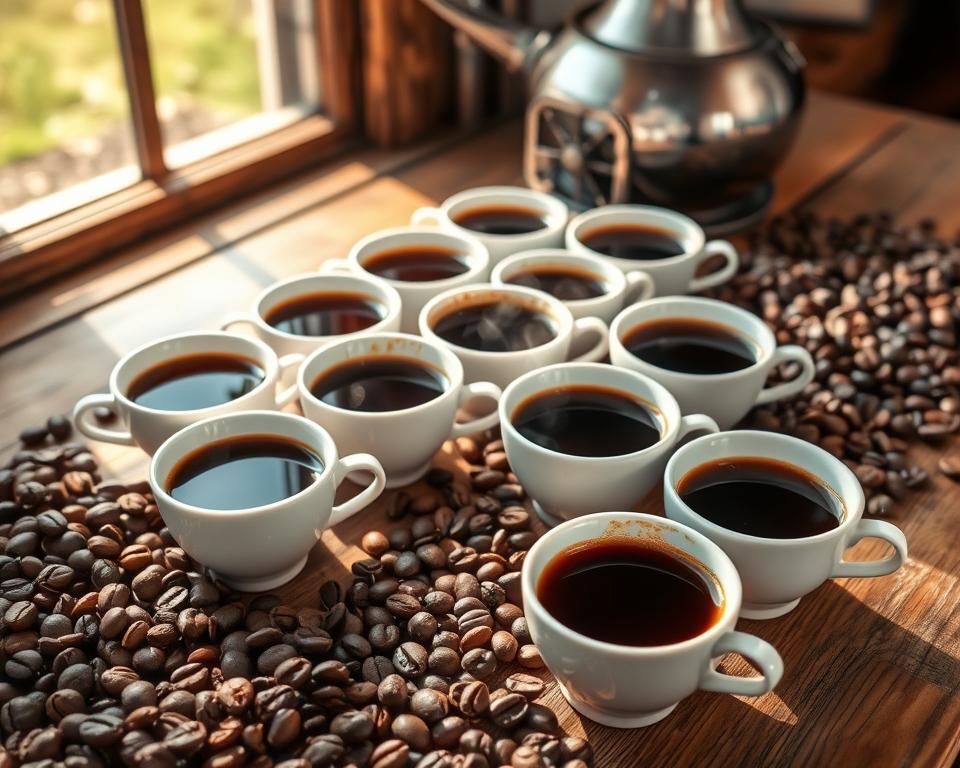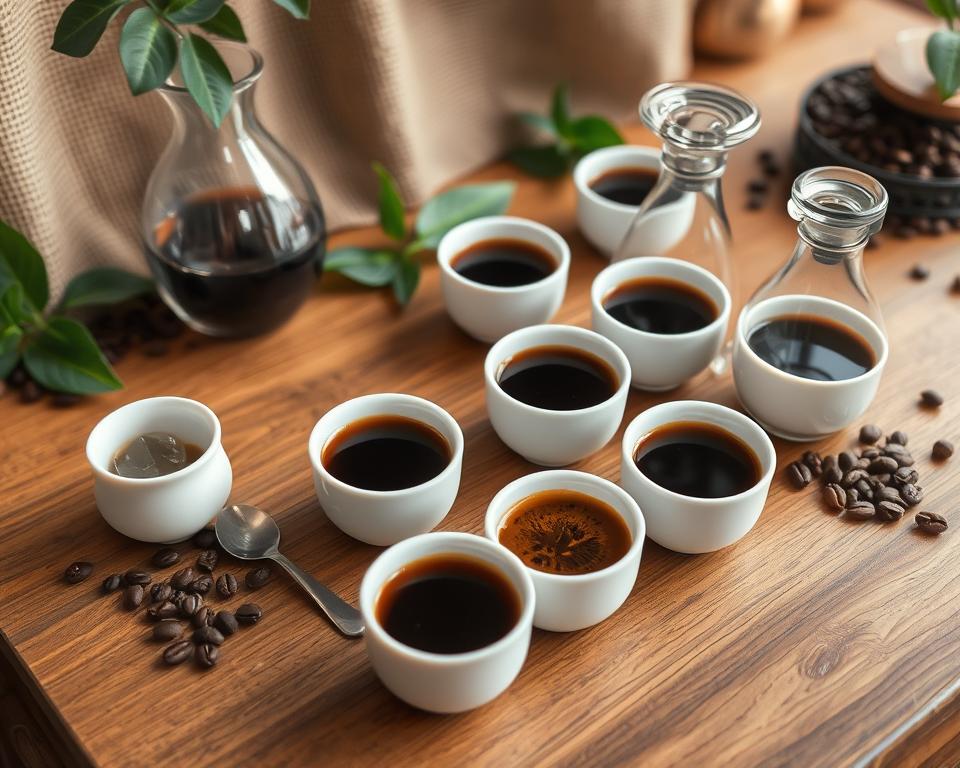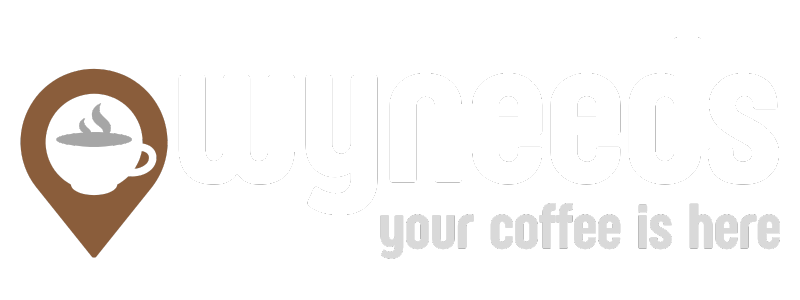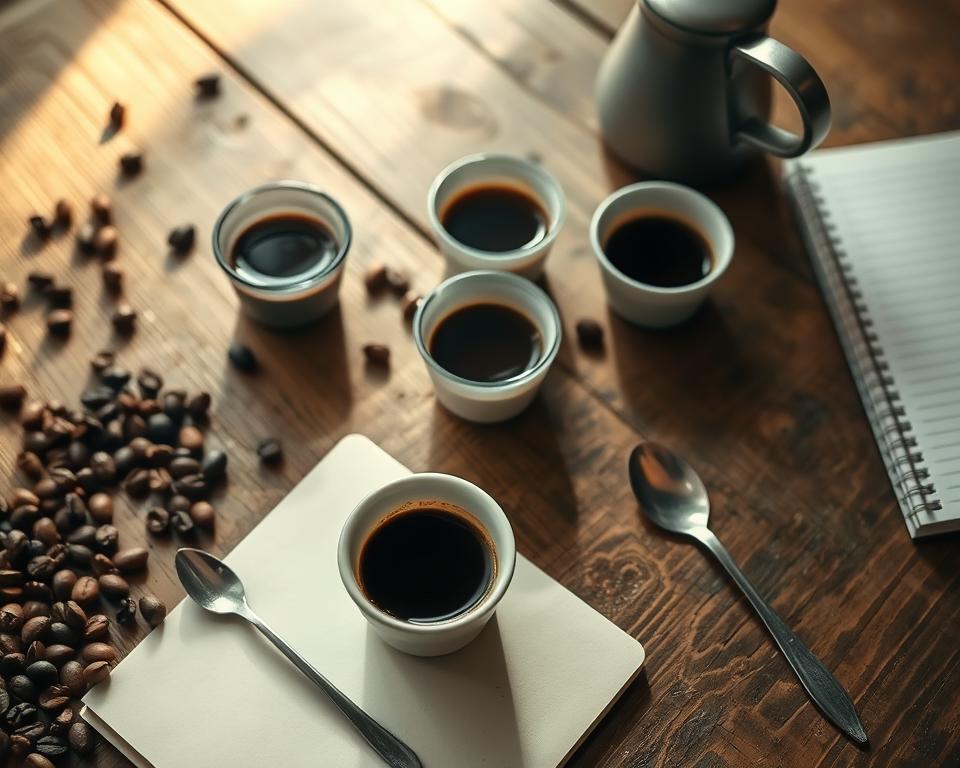Coffee cupping is a method used by coffee professionals and enthusiasts to evaluate coffee beans. It assesses flavors, aromas, and quality. With over a thousand aroma compounds, coffee cupping is an art form. It allows coffee lovers to explore the diverse flavors and aromas of different beans. This makes it crucial for specialty coffee tasting.
Mastering coffee cupping can elevate your coffee experience. It helps develop a deeper appreciation for coffee’s complexity. The Specialty Coffee Association of America (SCAA) employs thousands of professionals. They use coffee cupping to determine coffee quality, with scores above 80 considered ‘specialty’ coffee. Freshly roasted beans, at their peak flavor about one week after roasting, are ideal for cupping and tasting.
Coffee cupping involves a specific sequence. Tasting occurs at a cooled temperature, about 9 minutes after brewing. This process is essential for coffee enthusiasts. It helps them understand coffee’s nuances and appreciate the craftsmanship of high-quality specialty coffee.
Key Takeaways
- Coffee cupping is a standardized method for evaluating coffee flavors and aromas.
- Over a thousand aroma compounds contribute to a coffee bean’s taste and smell.
- Coffee cupping is essential for specialty coffee tasting and evaluating the quality of coffee beans.
- Freshly roasted coffee beans are ideal for coffee cupping and reach their peak flavor approximately one week after the roasting date.
- The Specialty Coffee Association of America (SCAA) employs thousands of coffee professionals who use coffee cupping to determine the quality of coffee beans.
- Coffee cupping involves a specific sequence, including tasting at a cooled temperature, to evaluate the flavors and aromas of the coffee.
What is Coffee Cupping?
Coffee cupping is a method used to assess the coffee flavor profile and coffee aroma evaluation of various coffee beans. It involves several steps, including deep sniffing, slurping the coffee to aerate it, and tasting it to evaluate its qualities. The main aspects evaluated are body, sweetness, acidity, flavor, and aftertaste.
Experts in coffee cupping suggest that the ideal temperature for tasting coffee is just below boiling. They use 8 oz. glass cups, which allow tasters to observe the coffee’s color and examine its foam and sediments. The term “body” in coffee tasting is compared to milk, with heavy body likened to whole milk and light body to skim milk.
The characteristics of coffee often reflect its region of origin, due to the unique flavors imparted by different environments. Coffee cupping is seen as similar to formal tea ceremonies in Chinese or Japanese traditions, emphasizing its significance in appreciating coffee’s complexities. For more information on coffee-related topics, visit coffee resources.
The Importance of Coffee Cupping
Coffee cupping is a vital process in the coffee world. It allows for the evaluation of coffee quality and flavor profiles. Through this method, producers and roasters can assess their beans’ quality and pinpoint areas for improvement. It involves a detailed evaluation of aroma, flavor, and overall quality, offering a comprehensive view of the coffee’s characteristics.
The Specialty Coffee Association (SCA) has developed a Cupping Sheet with scoring categories for Aroma, Flavor, Body, Acidity, Sweetness, and Balance. This standardized approach ensures coffee professionals can evaluate quality consistently and accurately. It helps maintain flavor consistency, crucial for single-origin coffees where batch variation can be significant.
Sourcing Quality Beans
Coffee cupping is key in sourcing high-quality coffee beans. It evaluates the flavor profile, aroma, and quality of beans, helping buyers determine their suitability for roasting and brewing. This ensures only the best beans are chosen, leading to a superior cup of coffee. Regular cupping sessions also allow buyers to compare different beans and select those that meet their quality standards.
Enhancing Flavor Profiles
Coffee cupping is essential for enhancing flavor profiles. It helps coffee roasters and brewers understand each bean’s unique characteristics. This knowledge enables them to optimize roasting and brewing techniques to highlight the best flavors. By identifying the optimal roast points and adjusting brewing parameters, professionals can refine their techniques to produce high-quality coffee that satisfies coffee connoisseurs.
- Aroma: The fragrance of the coffee, which can range from floral to fruity
- Flavor: The taste of the coffee, which can include notes of chocolate, caramel, or nuts
- Body: The texture and weight of the coffee in the mouth
- Acidity: The brightness and liveliness of the coffee
- Sweetness: The sweetness and balance of the coffee
- Balance: The overall harmony of the coffee’s flavors and characteristics
By considering these factors and using the SCA Cupping methodology, coffee professionals can conduct thorough quality assessments. This ensures the production of high-quality coffee that meets the expectations of coffee connoisseurs.
The Coffee Cupping Process
Coffee cupping is a detailed process that evaluates a coffee’s flavor, aroma, and quality. It’s a crucial step in the coffee grading system, revealing each coffee’s unique traits. To start, coffee beans are ground to a medium consistency, like table salt. They are then brewed in cupping bowls with a 1:18 coffee-to-water ratio.
The brewing time is 4 minutes, allowing the flavors to fully develop. During this period, the coffee is assessed at various stages. This includes dry and wet aroma, and again at 13-15 minutes post-brewing. This method allows tasters to fully appreciate the coffee’s flavors and aromas, such as coffee tasting notes like nutty, chocolate, and caramel.
Research shows that up to 20% of coffee lovers cup at home, reflecting its growing popularity. The rise of third-wave coffee shops has also boosted cupping. Many shops now host public cupping events and offer coffee cupping sessions for customers to explore different coffee origins.
Here are some key factors to consider when setting up a coffee cupping station:
- Use cupping bowls with a measuring capacity of 160ml to 200ml each
- Brew 10 grams of coffee for 180 milliliters of water per bowl
- Use a medium grind, comparable to table salt
- Assess the coffee at multiple intervals, including dry aroma, wet aroma, and at 13-15 minutes after brewing
| Coffee Sample | Grind Size | Brewing Time | Water Temperature |
|---|---|---|---|
| Arabica | Medium | 4 minutes | 200°F |
| Robusta | Medium | 4 minutes | 200°F |
How to Set Up Your Cupping Station
To host a successful coffee cupping session, setting up your station is crucial. You need a quiet, distraction-free environment with a comfortable temperature and minimal noise. Your workstation should be well-lit and spacious, accommodating all necessary equipment. This includes cupping bowls, a grinder, and a scale.
Organizing your workstation effectively involves several key elements:
- Cupping bowls: Typically hold about 200 grams of coffee each.
- Grinder: A burr grinder is preferred over a blade grinder for consistency.
- Scale: Necessary for measuring the coffee to water ratio, which is usually around 1:18.
- Water: Should be at an ideal temperature of around 200°F (93°C) for brewing.
By setting up your cupping station correctly, you can ensure a successful specialty coffee tasting experience. Remember to document your tasting experiences. This helps track your preferences over time and refine your understanding of coffee flavor profiles.
| Equipment | Description |
|---|---|
| Cupping bowls | Hold about 200 grams of coffee each |
| Grinder | Preferably a burr grinder for consistency |
| Scale | Necessary for measuring coffee to water ratio |
With the right equipment and a well-organized workstation, you can conduct a thorough coffee cupping session. Enjoy a rich specialty coffee tasting experience.
Understanding Coffee Flavor Profiles
Coffee’s flavor profiles are intricate, with a vast array of notes and aromas. Experts note that roasted arabica coffee contains thousands of unique chemical compounds. These compounds contribute to the diverse flavors we experience. With time and consistent tasting, identifying these flavors becomes more refined.
A flavor wheel aids in calibrating taste buds and standardizing flavor descriptions. The coffee cupping process uses specific terms to describe aroma, body, and flavor. This is crucial for evaluating coffee variations. Common notes include fruity, floral, sweet, and spicy.
- Fruity
- Floral
- Sweet
- Spicy
Coffee’s aroma greatly influences its taste. Eco-friendly coffee aromas are described in various ways. Recognizing flavors during cupping reflects consumer preferences. There are countless aromas to discover. By grasping coffee’s flavor profiles and aroma, one can deepen their coffee appreciation.
As one becomes more skilled in coffee cupping, they can better identify aromas and flavors. This enhances the coffee experience. Whether for professional or personal enjoyment, understanding coffee’s complexities is key to appreciating it fully.
| Coffee Flavor Profile | Description |
|---|---|
| Fruity | Flavors reminiscent of fruits, such as citrus or berries |
| Floral | Flavors with floral or herbal notes, such as rose or lavender |
Tasting Techniques in Coffee Cupping
Coffee cupping is vital for evaluating coffee bean quality. It requires specific tasting techniques to assess flavor and quality. Coffee beans cupping focuses on fragrance, aroma, acidity, taste, body, aftertaste, and balance.
In a coffee cupping session, multiple samples are tasted to evaluate quality and flavor. The coffee-to-water ratio, brewing time, and water temperature are key. A ratio of 1:18 is common, with a brewing time of about 4 minutes. The water should be at 93°C.
Tasters rate the coffee’s 8 key characteristics on a scale of 1 to 10. The taste evolves as the coffee cools, revealing various flavors. 
When evaluating coffee, consider several factors:
- Fragrance and aroma
- Acidity and taste
- Body and aftertaste
- Balance and overall quality
By focusing on these aspects and using proper techniques, coffee cupping enhances understanding of coffee nuances andcoffee quality assessment.
Common Mistakes to Avoid
In the realm of coffee cupping, several common errors can greatly affect the process’s accuracy and effectiveness. One major mistake is neglecting the preparation steps, which can result in inaccurate outcomes. This includes not cleaning and preparing the equipment properly and not adhering to the coffee grading system.
Another critical error is overlooking the importance of temperature and timing. The ideal temperature for coffee cupping ranges from 195°F to 205°F. The timing of the cupping process also plays a significant role. Following a standardized protocol is crucial to ensure the coffee tasting notes are accurate and dependable.
Common mistakes in coffee cupping include:
- Using improper equipment, such as a dirty or uncalibrated scale
- Not following the recommended coffee-to-water ratio
- Ignoring the importance of water composition and quality
Avoiding these common mistakes and adhering to a standardized coffee grading system can make coffee cupping a valuable tool. It helps evaluate the quality and flavor profile of coffee beans.
| Mistake | Effect on Cupping Results |
|---|---|
| Skipping preparation steps | Inaccurate results |
| Ignoring temperature and timing | Affected flavor profile and acidity |
| Using improper equipment | Unreliable results |
Coffee Cupping Etiquette
Coffee cupping etiquette is crucial for professional and respectful sessions. It’s vital to share opinions respectfully and understand the role of a cupping table. The Specialty Coffee Association suggests keeping silent during evaluation, following the “rule of silent work.” This helps participants focus on the coffee’s flavors and aromas without distractions.
In a coffee cupping session, participants taste multiple coffees, often with 3 cups each to check consistency. The Specialty Coffee Association advises preparing 3 to 6 cups of each coffee sample, with a minimum of 5 cups. This detailed process requires attention to sensory evaluation of the coffee. Specialty coffee tasting is complex, and knowing the etiquette can improve the experience.
Some key considerations for coffee cupping etiquette include:
- Maintaining a clean and organized cupping station
- Using the correct cupping ratio, as recommended by the Specialty Coffee Association
- Allowing the coffee to cool to the optimal temperature for tasting, around 71°C

By adhering to these guidelines, participants can ensure a positive and productive experience. Whether in a professional coffee cupping session or exploring coffee cupping and specialty coffee tasting, etiquette is essential. It enhances the overall experience.
Expanding Your Coffee Knowledge through Cupping
Coffee cupping is more than just tasting; it’s a journey into the heart of coffee appreciation. By connecting with local roasters and attending cupping events, you can deepen your understanding. These experiences let you dive into the subtleties of coffee flavor profiles and coffee aroma evaluation. This enhances your appreciation for the art of coffee.
Reaching out to local specialty coffee roasters is a smart move to stay updated on industry trends and techniques. Many roasters are eager to host cupping sessions. Here, you can taste their latest offerings and learn about sourcing, roasting, and brewing. These interactions can lead to discovering coffees that match your taste preferences.
Also, seeking out cupping events in your area is a great way to learn. Whether it’s a barista competition, a regional coffee festival, or a cupping workshop, these events are filled with coffee lovers and experts. By participating, you can improve your tasting skills, uncover new flavors, and engage in meaningful conversations with others who share your passion.
FAQ
What is coffee cupping?
What is the purpose of coffee cupping?
What is the importance of coffee cupping?
What are the steps in the coffee cupping process?
How should I set up a cupping station?
What are the key flavor notes to look for in coffee cupping?
What are the common tasting techniques used in coffee cupping?
What are some common mistakes to avoid in coffee cupping?
What is the etiquette for coffee cupping?
How can I expand my coffee knowledge through cupping?

Paul Allen is a writer at WyNeeds, a website dedicated to the world of coffee. Passionate about aromas and flavors, he explores everything from the best brewing methods to fascinating insights about coffee beans and industry trends. His goal is to provide readers with engaging and informative content, helping both beginners and coffee enthusiasts deepen their knowledge of the world’s most beloved beverage.

